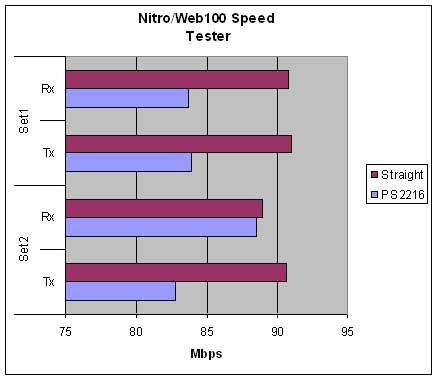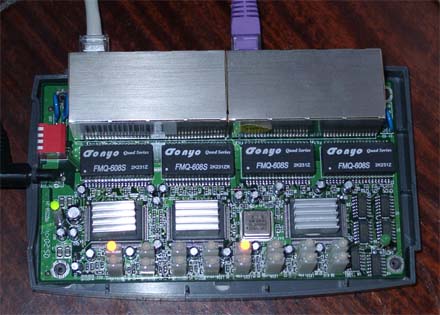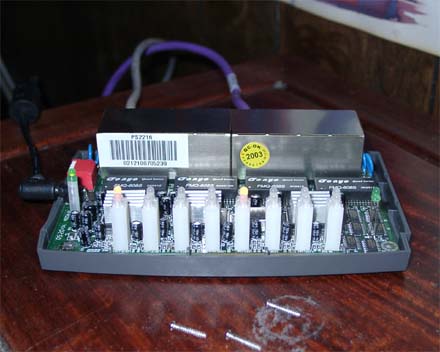PS2216 -- Performance and Measurements
Performance and Measurements
In theory, the speed of a LAN connection is the TCP window size divided by the round trip time (RTT). TCP window size is generally a multiple of the maximum segment size (MTU-40, about 1460 bytes). For those who used a registry tweak, it's set at 256960. So, the lower the latency on a network, the faster it will go.
Testing the latency of the PS2216 we plugged a laptop directly into a network drop, and ran Nitro, a java based Internet2 speed tester. Then by adding the PS2216 in the path we again ran Nitro and recorded the difference. The subnet we used had a little bit of traffic, which brought the numbers down a little bit, but it is the difference we're after. RTT for the runs were 4.67ms and 5.05ms.
And the numbers are:

Ah, my graphing skills are getting better. The PS2216 introduced about an 8% drop in overall performance, which is rather transparent, as far as network equipment goes. The difference looks larger than it is due to the fact that the graph doesn't start at 0. Only two sets were run. I know, I know, I should average the results, but Im lazy. And it was more of a graphing challenge.
To test whether or not the PS2216 would affect LAN play, I brought it to a LAN party. Thanks go out to Alex, Adam, Shane, and the dude that hopped the fence to come and play, for providing the space, power, and kitchen. Anyway, the PS2216 worked flawlessly from the moment we plugged it in with every game we tried, despite a mix of 10Mbps and 100Mbps NIC cards. The PS2216 replaced a small Netgear hub and saw pings hover around 4ms to 5ms with the PS2216 installed. If that isn't a small enough ping for you, you might need to go outside and get away from the CRT radiation!
It even survived a small cookie crumb disaster. Which necessitated...

I've got to hide the screwdrivers. There are four NIC cards squashed into each of those 'Tonyo' chips. The heatsinks were mildly warm to the touch and were epoxied on, so I wasn't able to check what they were. Without major surgury, anyway.

3.2Gbps is a lot of bandwidth. Just for fun, I made a loop with a chunk of Cat5 cable. The PS2216 did not enjoy the loop at all. By pinging through the switch, we saw the pings timeout, meaning that the PS2216 has some fairly poor buffer management. It should have been a piece of cake for a 3.2Gbps crossbar to handle a 400Mbps loop, but all of the input buffers were being taken up by the loop. You might get 3.2Gbps of internal bandwidth, but it isn't very well managed. Unplugging the loop would either deep fry the switch (rarely), requiring a power cycle, or it would eventually clear the buffer and return to normal. I didn't expect a switch in this price range to have spanning-tree protocol to manage loops, so, this is just for fun. Heh.
